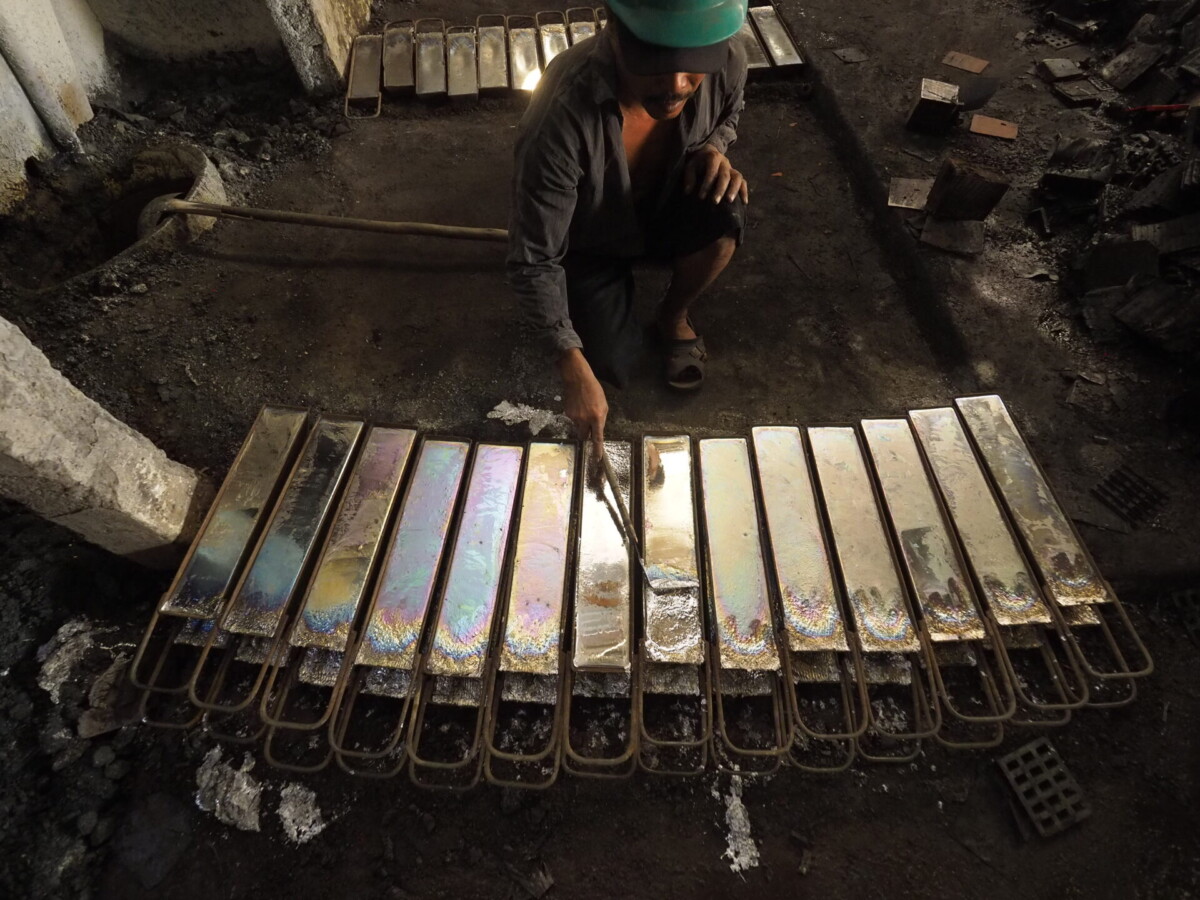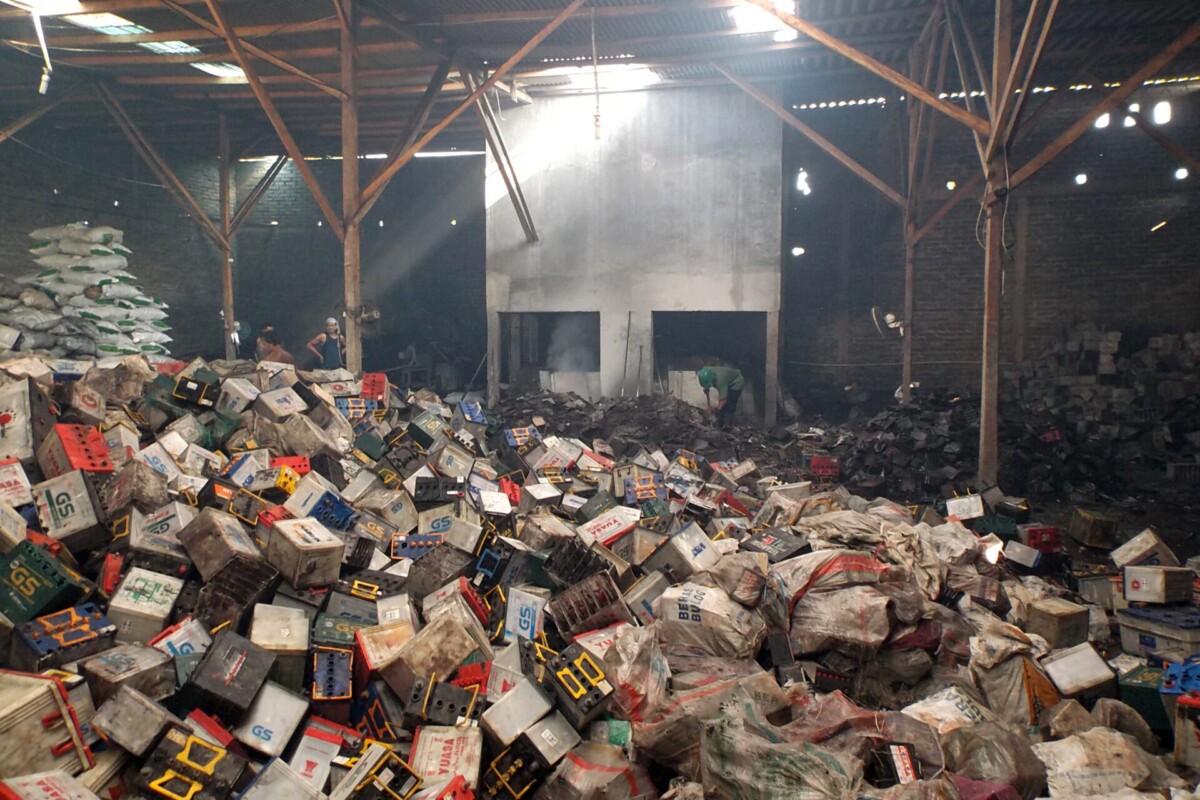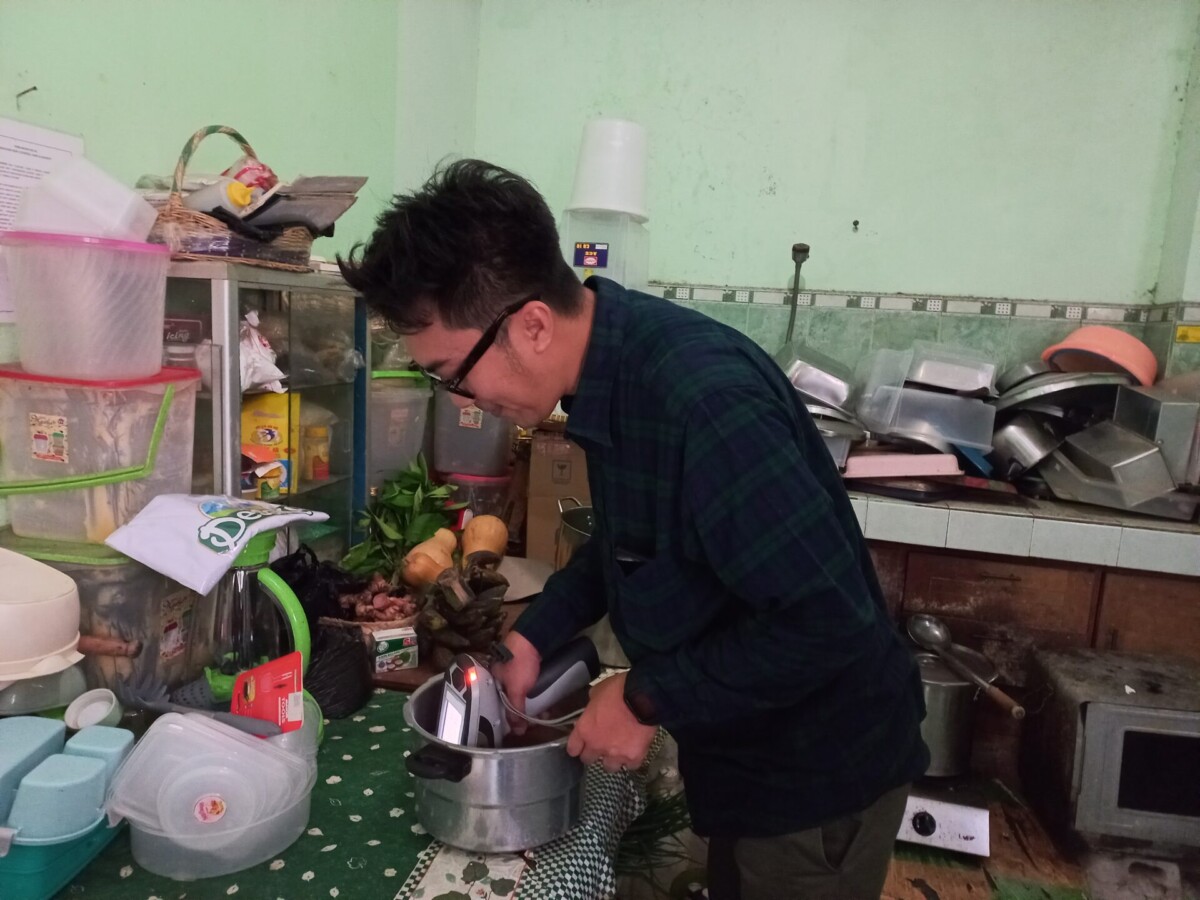Yayasan Pure Earth Indonesia Educational Materials Translated From Bahasa
WHAT IS LEAD?
Lead is a naturally occurring chemical element denoted with the symbol Pb derived from its Latin name plumbum. It has an atomic number of 82 and weight of 207.2. With its relatively lightweight, lead stayed in the Earth’s crust making it the thirty-sixth most abundant element in the planet’s exterior.
Lead is generally found already combined with other minerals such as sulfur, zinc, and copper. Galena, which mainly contains lead and sulfur (Pbs), is the most important ore of lead. Lead manufacturing includes a series of processes to filter other minerals and to refine the lead to get the finished product.
Lead is a bluish shiny gray metal that easily tarnishes into a dark gray when exposed to air. With a density of 11.34 g/cm3, lead is denser than most common metals yet soft and ductile. This high density makes it an efficient absorber of sound, vibration, and radiation. With this quality, lead is commonly used as a shield for x-rays and other forms of radiation.
Lead has a low melting point of 327.46 °C which, combined with its high malleability, allows it to be cast and fabricated easily. It is common for lead to be alloyed with other elements to make products with special properties for some specific application. Lead is also known for its corrosion resistance and high durability.

WHERE COULD WE FIND LEAD?
With all those desirable chemical and physical properties, combined with its abundance, recyclability, and a relatively low cost, lead has been extensively used for thousands of years. In the ancient times, lead was used for paints, glazes, and for various ornaments among many other uses.
The Roman Empire used lead for making water pipes to build its intricate plumbing system. This innovation still left marks in today’s sanitation system and even inspired the use of the Latin word plumbum as the origin of the English word plumbing.
In modern times, the use of lead has gotten even more versatile. Here are some of its most widespread use:
1. Batteries
Approximately 86 percent of lead worldwide is produced for lead-acid batteries. Lead-acid batteries are widely used in automobiles and backup power systems.
2. Paints and pigments
The use of lead as paints and pigments dates back since ancient times. Lead is added to paint to increase drying capacity and durability, as it resists moisture and helps prevent corrosion. As pigments, lead is used in many consumer products such as cosmetics, toys, and spices.

3. Alloys
Lead is commonly used in alloys and solders due to its low melting point and ability to bond well with other metals. Lead-based solders are used in electronics, plumbing, and cookware.
4. Plumbing
Lead’s resistance to corrosion and its malleability make it suitable for use in pipes and roofing materials.
5. Radiation shielding
Lead’s high density makes it an excellent material for blocking radiation. It is commonly used in medical and industrial settings to protect against X-rays and gamma rays.
COMMON SOURCES OF LEAD EXPOSURES
Despite its usefulness, lead is highly toxic and harmful. Naturally occurring concentrations of lead in soil, water, and air generally do not pose significant health risks to humans. But human activities over the past few thousand years, made lead more widely distributed. As a result, humans are more exposed to harmful levels of lead. Reports have shown that lead in the human body is up to 1,000 times higher than it was in pre-industrial times.
Today, we can find lead in the food we eat, the vehicles we drive, and even in our cosmetics. Unfortunately, this ubiquity also increases the risk of lead exposure. Here are some of the most common sources of lead exposures:
Informal Used Lead-Acid Battery Recycling
Recycled lead is the most common source of lead materials nowadays. Since the biggest use of lead is for producing lead-acid batteries, unsafe recycling of used lead-acid batteries (ULABs), most of which are found in vehicles like cars and trucks, has become one of the primary contributors to lead exposures.
Over the past decade, Indonesia has seen rapid growth of car ownership and increased demand for lead-acid batteries. In 2018, the Ministry of Environment and Forestry recorded that the number of motorized vehicles reached more that 146 million units and could produce more than a half million tons of used batteries. Along with the growth of motorized vehicles in the country, this number is expected to rise. It is predicted that the lead-acid batteries market in Indonesia will grow at a CAGR of 3.35% over the period of 2023 to 2027.

Generally there are two types of ULABs recyclers in Indonesia, the formal or licensed and the informal or unlicensed recyclers. While there are only five licensed ULABs smelters throughout the country, the exact number of informal ULABs recycling sites in Indonesia that are currently active are not known, nor are where previously active sites have resulted in significant lead contamination. However, it is estimated that there are more than 200 ULAB smelting locations throughout Indonesia. The five licensed smelters combined only have the capacity of 180,000 tons per year, far below the estimated number of ULABs annual production in the country which is around 400,000 metric tons. It means there is a huge gap of more than half of the capacity that the informal ULAB smelters will exploit.
Informal recycling activities often lack the necessary processes and technologies to control lead emissions and to protect workers and nearby communities from lead exposures. Such informal recycling operations typically occur in backyards, where workers without protection use hand tools to open batteries and extract lead plates. These plates are then smelted in open-air pits, releasing lead-contaminated fumes and particulate matter over surrounding neighborhoods.
The lead-laced acid from the batteries is often drained onto bare ground or directly into waterways, contaminating irrigation water, and crops. Plastic battery cases are also commonly recycled, and if not properly cleaned, they can contaminate other plastic products with lead. Residents, especially children, living near these recycling sites are at risk of lead exposure from the dust and fumes generated by these operations.
Studies have shown that children living near lead battery manufacturing and recycling facilities have average blood lead levels significantly higher, nearly four times the reference level of 5 µg/dL, which requires intervention.
Paints
In modern times, leaded paints were once widely used and greatly in demand since they cover surfaces well and give vivid color. With the recognition of the harmful impacts of lead exposure, the global use of lead paints is declining, since there have been international efforts to eliminate lead paint globally. However, as of 2019, only 73 countries have legally binding controls to limit the production, import and sale of lead paints.
A national study conducted by Nexus3 Foundation and International Pollutants Elimination Network (IPEN) in 2021 reported that around 79 percent of the sampled solvent-based paints for home and industrial uses in Indonesia contained lead concentrations above 90 ppm. More than one third of the sampled paints, around 39 percent, even contained extremely high lead concentrations above 10,000 ppm. To make the matter worse, less than a quarter of the sampled paints, or around 21 percent, provided any information about lead on their labels.
In May 2022, the National Standardization Agency of Indonesia (SNI) enacted a 90 parts per million (ppm) maximum voluntary limit for lead in decorative paint or various uses which is significantly lower than the previous 600 ppm. However, since it’s voluntary many producers don’t adhere to the standard and continue producing the harmful lead based paints.
Ceramics and Metal Cookware
Lead-glazed pottery and lead-added metal cookware is commonly used to cook and serve food in many countries including Indonesia, causing lead to leach into the food. Locally made aluminum cookware is also common in Indonesia. Informal artisans use scrap metal from products such as waste engine parts, vehicle radiators, lead batteries, and computer parts. Consequently, whatever metals are present in this scrap will be incorporated, including lead. Owing to the relatively light weight and low cost of the artisanal pots, as well as good conductivity which equates to lower usage of wood fuel, this type of pots are widely used.

Our recent research on lead in consumer goods found that 60% of metal cookware sampled in Indonesia contains lead that are above reference levels of 100 ppm. Currently, Indonesia has no regulations or legislations regarding cookware that have been put into place.
Consumer Products
– Toys
The use of lead in toys, particularly toys with plastic and painted wooden components, has historically been due to its affordability, durability, and vivid colors. However, lead in toys poses a serious danger to children, who are especially vulnerable to its toxic effects. Children often put toys in their mouths, increasing the risk of ingesting lead.
Our recent Rapid Market Screening found that 10% of plastic and wooden toys sampled in three cities in Indonesia, i.e., Surabaya, Medan, and Makassar, contain lead that are above reference levels of 100 ppm.
– Cosmetics
Lead has been historically used in cosmetics, primarily as a pigment in products like lipsticks, eyeliners, nail polish, eyeshadow, henna, and facial powders. It’s also valued for its ability to increase skin adhesion and provide a smooth texture.
Cosmetics emerged as one of the products with the highest percentage of samples exceeding the relevant reference levels in our recent Rapid Market Screening. Around 33% of cosmetics sampled contain lead that are above reference levels of 100 ppm.
– Spices
Lead contamination in spices is a significant health concern, primarily due to improper agricultural and manufacturing practices. Spices can become tainted with lead through contaminated soil, water, and the use of lead-containing pesticides. Additionally, during the drying, grinding, and packaging processes, lead from machinery or storage containers can infiltrate the spices.
– Lead-contaminated air
Lead-contaminated air is primarily stemming from industrial activities, such as metal smelting, battery manufacturing, and the combustion of leaded fuels. Although the use of leaded gasoline in Indonesia has been phased out since 2006, historical emissions continue to contribute to airborne lead, particularly in urban areas and near industrial sites. Lead particles released into the air can be inhaled directly or settle onto soil and water surfaces, leading to further contamination.
Another source for lead-contaminated air is peeled-off paints, especially from older houses. Lead releases from these paints are typically confined to areas close to the painted surfaces, but deterioration or removal through sanding or sandblasting can create high localized concentrations of lead dust in both indoor and outdoor air.
– Lead-contaminated water
The primary source of lead in drinking water is decaying pipes, fixtures, and solder used in plumbing systems. When water with high acidity or low mineral content flows through these pipes, it can corrode them, releasing lead into the water supply. Industrial discharges and improper disposal of lead-containing waste can also contribute to water contamination.
– Lead-contaminated soil
Lead can be present in soil and dust, particularly in areas with past lead-related activities such as industrial operations, smelting, or ULAB recycling. Regions where leaded pesticides were used or coal ash was dumped often have lead contamination. High lead levels are also found in soil near houses with chipped or peeled lead-based paint.
Historical deposits from the use of leaded gasoline and industrial sources can also still linger in the soil. When lead is deposited on the soil surface, it tends to accumulate in the top 1 to 2 inches unless disturbed by excavation or tillage. This lead is most concentrated in fine soil particles, which adhere to skin and clothing and can become airborne, posing another exposure risk to humans.
EXPOSURE PATHWAYS
There are at least three ways through which lead can enter the body:
1) Ingestion
This is the most common way lead enters the body, especially in children. Lead can be ingested through contaminated water, soil, dust, or food. Children are particularly vulnerable as they often put their hands or objects, which may be coated with lead dust, into their mouths. Consuming food grown in lead-contaminated soil and food stored in containers or cooked in cookwares made with lead can also lead to ingestion.
2) Inhalation
Breathing in lead fumes, particularly in occupational settings such as smelting and recycling lead containing materials can lead to significant exposure. Fine lead particles and dust can also become airborne and be breathed in, allowing lead to enter the respiratory system and then the bloodstream.
3) Skin absorption
While less common and generally limited to occupational contexts, lead can be absorbed through the skin. Organic lead–tetraethyl and tetramethyl–used in leaded gasoline as additives to increase octane rating can be absorbed dermally.





